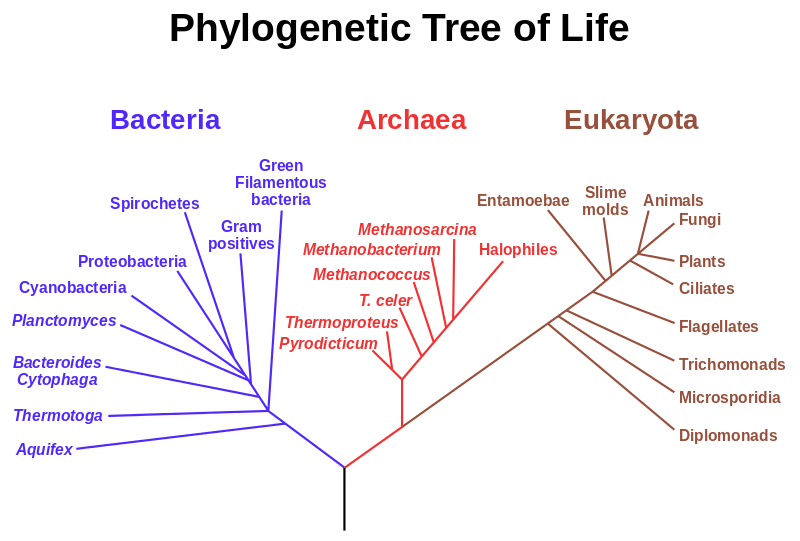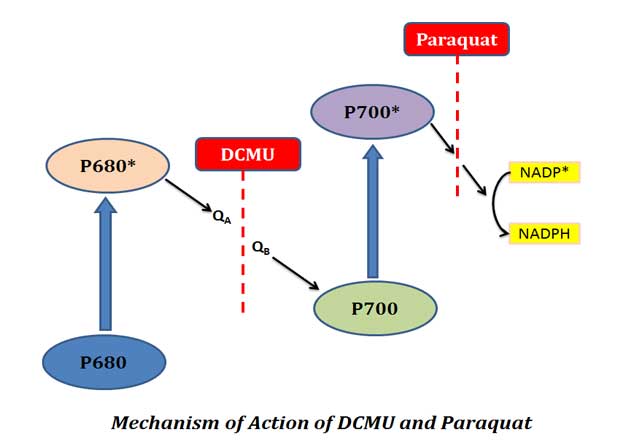(1). In pET expression vectors, high level of expression of cloned gene is achieved using
a. T7 promoter
b. SP6 promoter
c. Λ-PL promoter
d. Trp promoter
(2). Archaea is considered as a separate group from bacteria and eukaryotes, based on
a. Genome sequence
b. 16S rRNA gene sequence
c. 23S rRNA gene sequence
d. EFTu sequence
(3). A hybrid between species following by polyploidy or chromosome doubling is known as
a. Auto-polyploidy
b. Aneuploidy
c. Haploid
d. Allopolyploid
(4). The herbicide that kills plants by blocking the photosynthetic electron flow of photosystem-I is
a. Diuron
b. Paraquat
c. Glyphosate
d. Atrazine
(5). In submerged plants the root tip stimulates the activity of
a. ACC synthase
b. ACC oxidase
c. ACC synthase and ACC oxidase
d. ACC kinase
(6). Aroma in rice is due to
a. Acetyl choline
b. 4-benzyl pyrroline
c. 2-ethyl pyrroline
d. 2-acetyl-1-pyrroline
(7). The most preferred choice for development of hybrid plants from a male sterile line would be
a. Pollen culture
b. Anther culture
c. Ovary culture
d. Meristem culture
(8). Foraminiferans and radiolarians are
a. Non-photosynthetic protists
b. Photosynthetic protists
c. Microscopic bacteria
d. Biogenic sediments
(9). Which one of the following is an example of structural chromosomal aberration?
a. Edward’s syndrome
b. Down’s syndrome
c. Turner’s syndrome
d. Cru-du-chat syndrome
(10). Which of the following techniques can be used to determine the alpha-amylase gene polymorphism?
a. Southern blot
b. Slot blot
c. Dot blot
d. Northern blot
(11). Which of the following transgenic crops occupies the largest area in the world?
a. Herbicide tolerant soybean
b. Herbicide tolerant maize
c. Insect resistant cotton
d. Insect resistant potato
(12). In order to develop iron-rich rice which of the following genes was used for creating genetically modified plants?
a. Ferritin
b. Phytic acid
c. Phytic acid and Ferritin
d. Tranferrin and Ferritin
(13). Which of the following genes in Arabidopsis mediates interactions between floral meristem and floral organ identity genes?
a. SRE
b. MADS box
c. UFO
d. AP2
(14). Which of the following statements about prion proteins is incorrect?
a. Prion proteins form cross beta filaments
b. Prion proteins are heat resistant
c. Prion proteins are protease sensitive
d. Prion proteins can convert the normally folded protein to pathological form
(15). Carrageenan is composed of repeating units of
a. Galactose
b. Glucose
c. Glucose and galactose
d. Mannose
Answer key and Explanations
1. Ans. (a). T7 Promoter
pET expression system is the most powerful and commonly used expression system for the express recombinant proteins of interest in E.coli system. Target genes are cloned in pET plasmids under control of strong bacteriophage T7 transcription or translation signals. The expression is induced by providing a source of T7 RNA plymerase in the host cell. T7 RNA polymerase is so selective and active that, when fully induced, almost all of the cell’s resources are converted to target gene expression and the desired product can comprise of more than 50% of the total cell protein after a few hours of induction.
T7 RNA polymerase is the RNA polymerase enzyme of T7 bacteriophage. T7 polymerase is extremely promoter-specific and transcribes only DNA downstream of a T7 promoter (TAATACGACTCACTATAG)
2. Ans. (b). 16S rRNA gene sequence
Three domain classification system is the current and most accepted system of classification of biological organisms. It was proposed by Carl Woese in 1977 based on difference in the 16S rRNA sequence. This system describes only three major groups specified as ‘domains’ namely Archaea, Bacteria, and Eukarya. The most striking feature of three domain system is the separation of the traditional prokaryota into two groups namely Archaea and Eubacteria.

Three Domain System Phylogenetic Tree (source wikipedia)
3. Ans. (d). Allopolyploid
Two types of polyploids: (1) auto-polyploids and (2) allopolyploids. In Autopolyploids the same chromosome set repeats many times, such as triploid (AAA) tetraploid (AAAA) pentaploid (AAAAA) hexaploid (AAAAAA) etc. Autopolyploids are sterile; they cannot produce fertile gametes after meiotic division since they are unable to undergo homologous pairing of chromosomes.
Allopolyploids are hybrids which are made fertile by chromosome doubling; such as triploid (AABBCC), tetraploid (AABBCCDD) etc. Allopolyploids are fertile since they can undergo homologous pairing in meiosis and can produce fertile gametes. Thus allopolyploids are also called as amphidiploids.
Aneuploidy: a chromosomal variation where the change is by either addition or deletion of specific chromosomes (not the whole set). Example: monosomy (2n-1), nulisomy (2n-2), trisomy (2n+1), tetrasomy (2n +2)
4. Ans. (b). Paraquat
Paraquat and Diuron (DCMU or Dichlorophenyl Dimethylurea) and Atrazine are synthetic herbicides which act by blocking the electron transport system in photosynthesis.
Mechanism of action of paraquat: paraquat accept electron from early acceptors of photosystem I and then it react with oxygen to produce reactive radicles (super oxide (O2-)). These super oxides destroy chloroplast by destroying the lipids in the membrane.
Mechanism of action of diuron: Diuron block the electron flow at the quinone acceptor of photosystem II by competing for the binding site of plastoquinone that is normally occupied by QB.

For details, please refer: Plant Physiology by Taiz, Chapter: 7, Photosynthesis: The light reaction; page 133
Mechanism of action of atrazine: atrazine binds to plastoquinone-binding protein in photosystem II of electron transport system in light reaction. This cause starvation in plants and also causes oxidative damage in the high intensity of light.
Glyphosate: is an organophosphorus broad spectrum synthetic herbicide, discovered by Monsanto and brought into market in the trade name ‘Roundup’. Glyphossate act by inhibiting the enzymes for the synthesis of aromatic amino acids in plants
5. Ans. (c). ACC Synthase and ACC oxidase
6. Ans. (d). 2-acetyl-1-pyrroline
7. Ans. (c). Ovary culture
8. Ans. (a). Non-photosynthetic protistis
9. Ans. (d). Cri-du-chat syndrome
Cri-du-chat syndrome is a disorder in human caused by a structural aberration of chromosome. It is caused by the deletion of a piece from the p-arm of chromosome 5. The name is a French term for cat crying, referring to the characteristic cat-like cry of affected children.
Edward syndrome: a disorder in human by numerical aberration of chromosome. It is caused by trisomy at 18th chromosome (trisomy 18)
Down’s syndrome: another numerical aberration in human caused by trisomy at 21st chromosome
Turner’s syndrome: a sex chromosomal numerical aberration in human caused by monosomy of sex chromosome. The individuals will be females with XO chromosomal constitution (they lack one X chromosome in their somatic and germ cells)
10. Ans. (a). Southern blot
Southern blot: a molecular biology technique for the detection of specific DNA segments in DNA samples, developed by E.M. Southern. The electrophoresed DNA sample were blotted to a membrane and hybridized with the known probe
Dot blot or slot blot: A molecular biology blotting technique for detecting small organisms such as bacteria, bacteriophages and virus or biomolecules such as proteins, nucleic acids etc.
Northern blot: a blotting technique for the detection of RNA in the sample
11. Ans. (a). Herbicide tolerant soybean
12. Ans. (c). Phytic acid and Ferritin
13. Ans. (c). UFO
UFO or UNUSUAL FLORAL ORGANS is a gene in Arabidopsis involved in the floral development. UFO is required for the proper identity of the floral meristem and acts in three different aspects of the process that distinguishes flowers from shoots. UFO is also involved in establishing the whorled pattern of floral organs, controlling the determinacy of the floral meristem and activating the APETALA3 and PISTILLATA genes required for petal and stamen identity
14. Ans. (c). Prion proteins are protease sensitive
15. Ans. (a). Galactose
Carrageenans are polysaccharides obtained by marine algae Chondrus crispus (Irish moss). It is a complex polysaccharide of sulfated and un-sulfated galactose and anhydrogalactose connected by alternating α-1, 3 and β-1,4 glycosidic linkages. Carrageenans are extensively used in food industry.
CSIR NET June 2016 Model Question Paper: Set 1 | Set 2 | Set 3 |
You may also like…
@. NET Life Science Model Questions
@. Biology MCQ
@. NET Life Sciences Lecture Notes
@. Biology PPTs
| You may also like NOTES in... | ||
|---|---|---|
| BOTANY | BIOCHEMISTRY | MOL. BIOLOGY |
| ZOOLOGY | MICROBIOLOGY | BIOSTATISTICS |
| ECOLOGY | IMMUNOLOGY | BIOTECHNOLOGY |
| GENETICS | EMBRYOLOGY | PHYSIOLOGY |
| EVOLUTION | BIOPHYSICS | BIOINFORMATICS |

